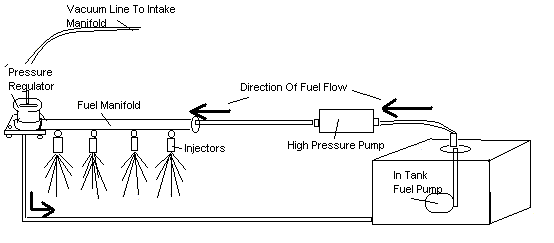


This is a fuel injection help page for those who think the now old technology is to complicated to be serviced by the shadetree mechanic Its not as complicated as you think.
The EGR System Can Drive You Nuts See how it works...
To See a Little Bit of Info on Sensors go here...
The first type I cover is Fords way, but all ford vehicles may not use the exact type of injection stated below but most of them do.
The injector(s) work by opening and closing. The computer sends an electrical signal to the injector to open it (lift the pintle up) allowing a quick mist to spray into the intake. After the injector sprays a shot of fuel, the computer then stops the electrical signal to the injector. A spring is what closes the pintle.
If you think you have a fuel problem and your vehicle is fuel injected most of the time the fuel pump is the culprit. the second most common problem is the filter will clog. Most of the time your problem may seem to be fuel related though it will end up being in the handfull of electric sensors that the computer uses to regulate fuel delivery.
The o-rings can leak over time. There are 2 o-rings on injectors. On EFI, CFI, and Multi point injection the injector will be "top" feed, meaning the fuel enters the injector at the top of the injector. So there will be an o-ring at the top and the bottom of these type injectors.
On TBI injection the injectors are "side" feed meaning the fuel enters the injector from the side. They also have 2 o-rings. One large o-ring at the top/edge and one small one on the bottom.
The injectors themselves "rarely" go bad.
Lets follow the fuel on a journey from the fuel tank, to the injectors, to the regulator then back to the fuel tank.
The fuel in the tank is picked up by a low pressure or hi pressure pump. Some vehicles have different pump set ups. Some have 1 pump in the tank. Another type has 1 pump in the tank and 1 on the car chassis near the fuel tank. On these 2 pump systems the pump in the fuel tank is a low pressure feed pump that feeds the hi pressure pump(It seems redundant but the high pressure pumps cannot prime (suck) the fuel on there own)
After the fuel goes thru the pump(s)the fuel then is pumped to the fuel filter.
After going thru the pump(s) then filter, the fuel goes to a tube shaped manifold which the top of the injectors are connected to. The bottom of injectors are connected the intake manifold on the engine. The top of the injector is pushed into the tube with an o-ring to seal the fuel from leaking. The bottom of the injector is pushed into the intake with an o-ring to seal fuel and vacuum.
While the fuel is in the manifold tube the computer is quickly opening and closing the injectors. Some fuel will go into the engine thru the injectors but most will bypass thru the pressure regulator where after passing thru, the fuel goes back to the tank to start over again.
"Regulator" On the opposite end of the manifold (metal rod), you will see a small can which has a black vacuum hose that goes from the top of the can to the engine (intake manifold).
This can is the fuel pressure regulator.
The fuel pressure is created by the fuel pump pumping the fuel between the pump and the regulator (can). The fuel manifold tube with injectors is in between the pump and the regulator The regulator is where the pressure is controled. It acts like you putting your thumb over a water hose trying to hold the water back that is basiclly how the regulator creates pressure.
***On the TBI, which has no tube. It does have the fuel pressure regulator after the injectors.
Since the fuel going to the injectors does not all go out the injectors to the engine some fuel will pass by the regulator and return to the fuel tank.
Any fuel that passes through ends up back in the tank to get pumped up all over again.
Now the injectors on a Ford open and close at one speed that never changes.
So to get more fuel to the engine when the injectors are only opening and closing at a certain speed you have to change the amount of fuel pressure in the manifold (rod).
The way its done is by the variable pressure regulator (can) sensing the vacuum in the intake manifold. The vacuum changes by pushing the throttle, that vacuum change either makes the fuel pressure rise (lower vacuum)as when the throttle is opening to speed up. Or the fuel pressure to drop (high vacuum) such as when its idling or decelerating.
When you push on the accelerator the vacuum goes to about 0" vacuum, almost closing off the flow in the regulator (can) so the pressure rises in the fuel line over the injectors thus more fuel flows through the injectors to the engine VVVRROOOOMM!
The electronic pulses that open and close the injectors come from the computer, the computer also controls the ignition timing by way of all the sensors.

The main difference is instead of the fuel pressure going up and down, while the injectors keep a steady pulse like ford. the GM fuel pressure stays constant while the injectors are open longer.
GM has the typical low pressure and high pressure pumps (sometimes only one pump). GM also uses a regulator BUT this regulator keeps the fuel at a constant pressure.
So to get more fuel to the engine the computer controls the amount of time the injectors are kept open (totally different from ford).
The computer gets the information on how much fuel to add to the engine by using the intake manifold vacuum.
The MAP sensor (manifold absolute pressure) is the sensor that tells the computer when to add fuel. The MAP works by being connected to the intake manifold sensing vacuum. The computer sends the MAP sensor a 5 volt positive wire. This 5 volts is used by the MAP in this way. To send a variable voltage back to the computer thus telling the computer what the engines needs are. from 1 to the 5 volts are sent back, again the MAP senser just sends the voltage back, 5 volts into the MAP senser from the computer, then depending what the engine is doing the vacuum in the engine gets turned into a voltage by the MAP senser then the MAP senser sends a voltage back to the computer.
So when you push the pedal toward the floor the voltage going back to the computer is at around 1 volt then as you push on the gas pedal the voltage goes up up up. Again from 1 volt at idle to 5 volts wide open throttle.
Remember that this MAP sensor is working by the vacuum that is in the intake manifold.
The MAP senser is not the only senser that informs the computer of whats going on BUT it is the most important senser that is used, the others such as the oxygen senser just fine tune the amount of fuel that is sent into the engine via the injectors.

*If your vehicle's engine just stops running without any indication of prior troubles you may want
to check below.
*Check for spark, if there is no spark and its a Ford chances are the "TFI" brain that is attached
to your distributer is bad. Or there is a pickup in the distributer they go out almost as often.
*GM engine with no spark check the "electronic module" in the distributer or underneath the distributer cap.
*Check for fuel, if there is no fuel flow check for fuel in the tank, fuel pump not working, fuel filter. Fuel
pump relays rarely go bad.
* Most problems that cause your engine to run bad when the typical tune up
parts are in good shape ie, plugs, wires, ect. are in the "control" sensors. The fuel
injection itself rarely goes bad except for: Fuel pumps go bad
:Fuel filters get clogged :Vacuum lines become cracked or strech creating leak
* Another problem that occurs is after a sensor goes bad such as the spark
pickup in the distributer goes out (hall effect). Your engine will not have spark.
So in turn you crank the engine 25-100 while trying to figure out what is
the problem you un-beknowingly flood the spark plugs every time you try to start it.
Doing so creates another problem. After finally getting the part that went bad
replaced your vehicle still wont start. So you may replace sensor after
sensor for no reason when all that is wrong is the plugs are splash fouled meaning
the plugs will not spark enough to run the engine until the plugs are
replaced.
* "Splash Fouling" occurs occassionally on fuel injection engines
that are cranked over and over during trouble shooting. "Splash Fouling"
means that raw fuel has been compressed but not fired creating a
problem that is not fixable. I do not know exactly why the plugs are ruined
by this but "MY HUNCH" is the raw gas gets compressed inside the plugs
porcelain creating an area where the spark energy can go to ground
thru the porcelain instead of thru the gap. Even if you clean your plugs until they
shine, they are still useless when this occurs. I have seen this happen occasionally.
****************************************************************
For help with Home Air Conditioning go to my A/C & REFRIGERATION Site.
For Home Air Conditioning Electrical Wiring Go To My AC ELECTRIC WIRING Site
Please visit my other links below
For questions or comments write:
 jbabs714@combase.com
jbabs714@combase.com